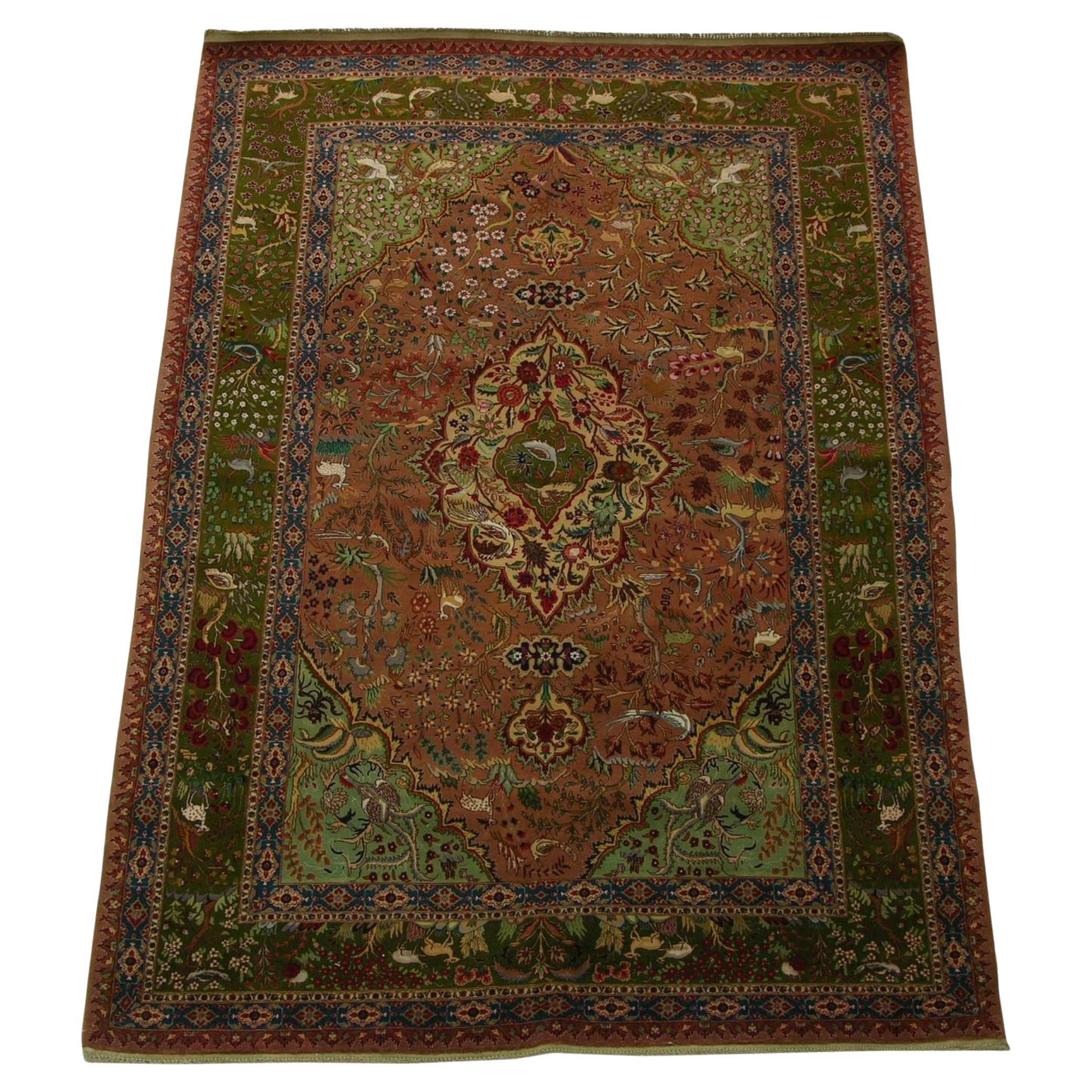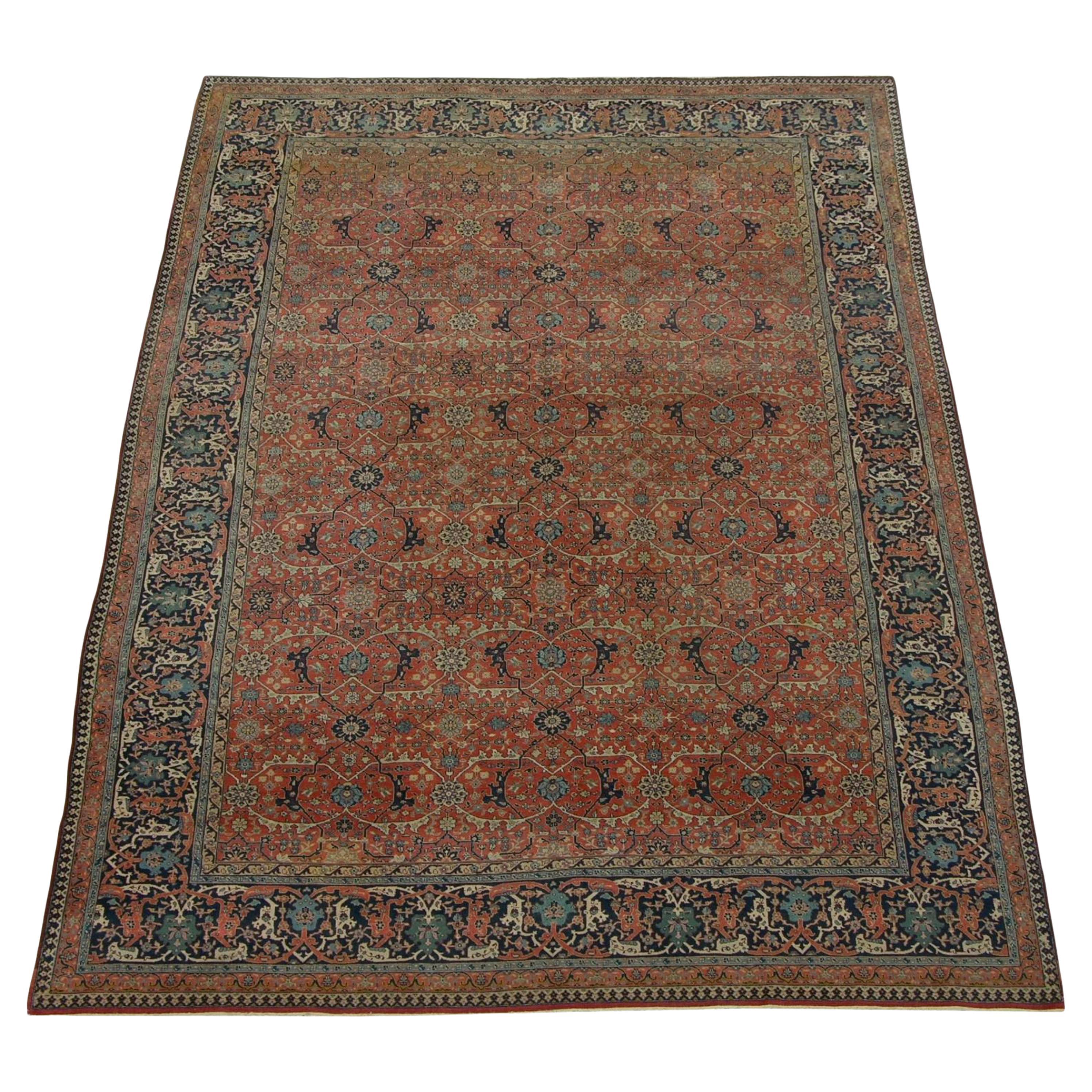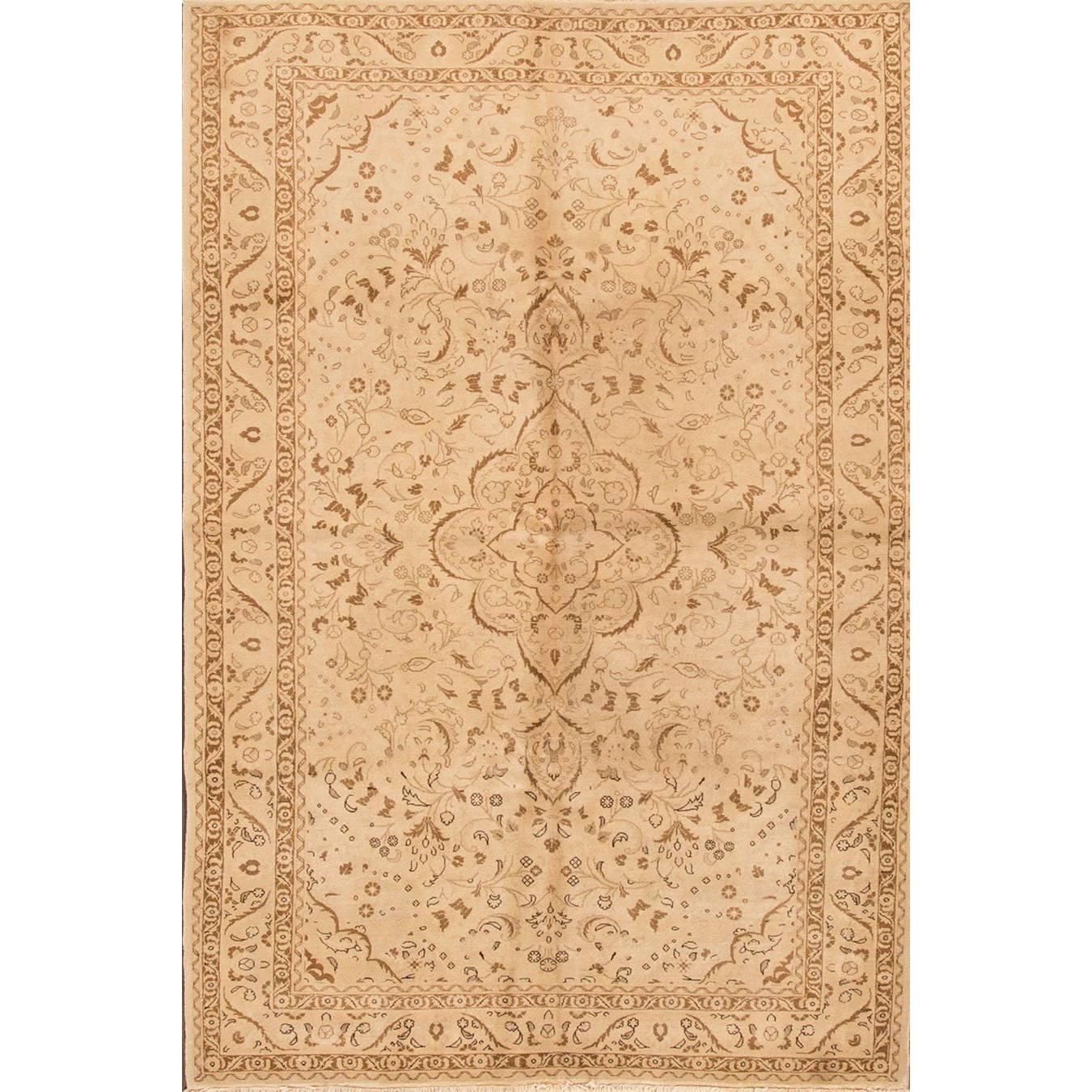Want more images or videos?
Request additional images or videos from the seller
1 of 5
1940s Vintage Tabriz Rug
About the Item
Located in the far northwest of Persia, Tabriz has been a leading center for the production of the finest rugs and carpets since the fourteenth century if not earlier. By 1500 it had emerged as a major capital of Safavid power and many of the carpet masterpieces of this period were made there.
- Dimensions:Width: 99 in (251.46 cm)Length: 133 in (337.82 cm)
- Style:Other (In the Style Of)
- Materials and Techniques:
- Period:
- Date of Manufacture:1940
- Condition:good condition.
- Seller Location:Los Angeles, US
- Reference Number:
About the Seller
5.0
Gold Seller
These expertly vetted sellers are highly rated and consistently exceed customer expectations.
Established in 1920
1stDibs seller since 2023
28 sales on 1stDibs
Typical response time: <1 hour
- ShippingRetrieving quote...Ships From: Los Angeles, US
- Return PolicyA return for this item may be initiated within 3 days of delivery.
More From This SellerView All
- Vintage Red Tabriz RugLocated in Los Angeles, USAntique Tabriz rugs are distinguished by their excellent weave and by their remarkable adherence to the classical traditions of antique Persian rug design. But they cannot be distinguished by any particular pattern or by their coloration. The city of Tabriz, in northwest Iran / Persia , was the earliest capital of the Safavid dynasty, and it can claim to have been a center of carpet production longer than any other city in Iran. Consequently, it is not surprising that the carpets woven there have been able to preserve the highest technical standards and the most varied repertoire. Antique Tabriz rugs offer classical medallion designs and a host of allover patterns as well in every color imaginable, from brilliant rich tones to soft pastels. What sets them apart from other Persian rugs is their quality. Tabriz is the capital of Azerbaijan, a province in the north of Iran. It has survived repeated destruction by numerous earthquakes and invasions by the Mongols, Tamerlane, Ottomans and Afghans, as well as two Russian occupations. During the late 19th century three Persian master-weavers, Haji Jalili, Sheik Safi and Kurban Dai contributed to Tabriz’s revival and Tabriz rug merchants began exporting Persian antique rugs to Western markets on a large scale. There is no traditional color scheme and the variety of color is limitless, ranging from rich jewel tones to subtle pastels. Tabriz rugs are precisely drawn and executed with care making them extremely popular among designers. Traditionally, Tabriz has been a city of master weavers. The ateliers in this influential carpet-weaving city established a strong reputation for classicism and quality that is still respected today. Regional carpets feature effortless curve-linear designs, Safavid emblems, allover Herati (fish) patterns, spectacular medallions and masterful motifs of all shapes and sizes. Antique Tabriz rugs have been sought after by rug aficionados for decades. They are not only one of the finest groups of Persian rugs to have been produced in Persia, they are also extremely decorative as well. The rugs of Tabriz are among the most beautiful and most desirable of antique Persian rugs, and have been manufactured in the Azeri speaking area of Northern Iran continuously for centuries. There are few things in this fine world that say true chic status. Sure, everyone has champagne wishes and caviar dreams. I mean I know I, personally, wake up everyone morning and take a bath in Dom Perignon. All that being said, when you aren’t jet setting to St. Bart’s for the weekend or going yachting on the Mediterranean, you are spending some hefty time in that luxurious pile of bricks you made home for yourself. What better way to deck out your pad than with a piece of beauteous history with our featured rug, Antique Tabriz rugs. Nazmiyal Antique Rugs...Category
Vintage 1960s Other Russian and Scandinavian Rugs
MaterialsWool, Cotton
- Antique Tabriz Rug Floral DesignLocated in Los Angeles, USAntique Tabriz rugs are distinguished by their excellent weave and by their remarkable adherence to the classical traditions of antique Persian rug design. But they cannot be disting...Category
Antique Early 1900s Asian Other Russian and Scandinavian Rugs
MaterialsWool, Cotton
- 1900 Vintage Khotan Samarkand RugLocated in Los Angeles, USAntique Samarkand Rugs: The desert oasis of Khotan was an important stop on the Silk Road. The people of Khotan were expert carpet weavers who produced high quality antique rugs and ...Category
Antique Early 1900s Other Russian and Scandinavian Rugs
MaterialsWool, Cotton
- 1950s Vintage Floral Design Needlepoint RugLocated in Los Angeles, USAncient Roots Of Needlepoint Rugs Archaeologists and scholars consider the roots of needlepoint to have been around 1500 BC. They consider the first needlepoint to include the fine diagonal stitches that were used to sew tents together by the ancient Egyptians. The art eventually evolved into tapestry weaving. However, a tapestry weaving differs significantly from needlepoint in that it uses a loom and vertical warp. Tapestry weaving is closer to the weaving of kilims and pile rugs than canvas work. However, some still include tapestry weaving in the category of needlepoint because of the fine work that appeared during the late Renaissance. It can have a similar appearance to the untrained eye. Technically, tapestry weaving and needlepoint are not the same, and they do not use the same technique. The first actual needlepoint rugs and needle-points began to appear in the late Renaissance. Needlepoint is worked by creating stitches on a stiff canvas. The canvas is typically made from jute or linen and is quite durable. Pieces from the Renaissance were used to cover footstools, chairs, pillows, bed headboards, and other furnishings. They were also used as table coverings and wall coverings. You could also find them on many small items such as purses, shoes, and various adornments for clothing. During the Renaissance, the craft reached a high level of skill, and the designs became incredibly detailed and realistic. They mimicked many of the subjects and styles of famous paintings of the time. They created florals, still life designs, scenes, and geometric tiled pieces. Some of them mimicked the designs found in Persian Carpets. Needlepoint reached its peak popularity in the 19th century when it was considered a proper occupation for a lady. Needlepoint and embroidery held a similar place in societal status at the time. During this time, the work became finer, with some of the canvas reaching a high level of detail. The level of detail is determined by counting the number of mesh in an inch. During this time petit point by French needlewomen could have a mesh count as high as 45 mesh. This allowed women to create highly intricate designs with incredible levels of detail. Historical Needlepoint Carpets and Rugs It is possible to find many antique pieces of needlepoint besides rugs. Needlepoint rugs were popular in France and Spain, where the technique was adapted to create highly intricate designs that mimicked the designs in architecture and fashion. They were popular because they were durable, and it could be fashioned into a variety of items. The canvases themselves were durable, and the wool that they used was also strong, which means that many of the pieces were able to withstand daily use. We have many artifacts that have survived from this time period. Needlepoint rugs are important collectibles because they are different from the pile rugs and kilims that are typically found on the market. Needlepoint carpets are special because they take many hours to create, especially larger works. Needlepoint pieces of any type became popular throughout Europe during the 19th century. It is still a popular hobby today, but perhaps one of the most interesting stories is that of the Portuguese needlewomen of Arraiolos. The story of these women and their beautiful carpets begins in 1492. Needlepoint was a popular occupation in Spain, which had a large population of Moors and Jews. They were an integral part of Spanish culture. However, in 1492, Queen Isabella of Spain issued a proclamation that gave these ethnic groups the order to pack their bags and board ships headed...Category
Vintage 1950s Other Russian and Scandinavian Rugs
MaterialsWool
- Vintage Central Asian Style Samarkand RugLocated in Los Angeles, USAntique Samarkand Rugs: The desert oasis of Khotan was an important stop on the Silk Road. The people of Khotan were expert carpet weavers who produced high quality antique rugs and ...Category
Antique Early 1900s Other Russian and Scandinavian Rugs
MaterialsWool, Cotton
- 19th Century Vintage Samarkand RugLocated in Los Angeles, USAntique Samarkand Rugs: The desert oasis of Khotan was an important stop on the Silk Road. The people of Khotan were expert carpet weavers who produced high quality antique rugs and ...Category
Antique 19th Century Other Russian and Scandinavian Rugs
MaterialsWool, Cotton
You May Also Like
- Beautiful Turkish Kilim Rug Antique of the 1940s, Tribal RugLocated in Bochum, NRWTurkish Kilim, of the 1940s. This colorful antique kilim has a bold presence provided by its graphic geometric motifs realized in shades of vivid green, sky blue, dark red, olive, ac...Category
Vintage 1940s Balkan Bessarabian Russian and Scandinavian Rugs
MaterialsWool
- Circa 1940 Vintage European Wool Rug with MedallionLocated in Ferrara, ITThis is a semi-antique European rug woven circa 1940 and measures 267 x 262CM in size. This carpet has a highly unique pictorial design with three interconnected circles in the field...Category
Mid-20th Century European Other Russian and Scandinavian Rugs
MaterialsWool
- Antique Russian Area Rug Tabriz DesignLocated in Dallas, TXAntique Russian area rug handwoven from the finest sheep’s wool. It’s colored with all-natural vegetable dyes that are safe for humans and pets. It’s a traditional Tabriz design hand...Category
20th Century Russian Tabriz Russian and Scandinavian Rugs
MaterialsWool
- Vintage 1940s Beige, Tan Persian Tabriz RugLocated in Norwalk, CT1940s Persian Tabriz rug with a beige field and traditional medallion design in darker tan. Measures 4’8” x 7’6”Category
Vintage 1940s Persian Persian Rugs
MaterialsWool
- Marta Maas-Fjetterström 'White Pointed Arch', Sweden, 1940sBy Märta Måås-FjetterströmLocated in New York, NYMid-20th Century Swedish Pile and Flat-Weave Carpet Initialed: AB MMF MH (AB Märta Måås-Fjetterström, Marin Hemmingsson). Sweden, circa 1943. 100% wool on linen foundation. ...Category
Mid-20th Century Swedish Scandinavian Modern Russian and Scandinavian Rugs
MaterialsWool, Linen
- Vintage 1940s Persian Tabriz Rug, Handcrafted Geometric DesignLocated in Dallas, TXStep into a world of sophistication with this captivating, handcrafted Persian Tabriz rug, woven circa 1940s. This exquisite piece showcases a timeless geometric design, brought to ...Category
Vintage 1940s Unknown Tabriz Persian Rugs
MaterialsWool





